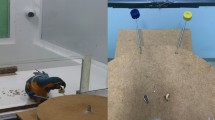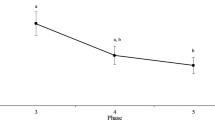Abstract
Peck rates (pecks/min) were used to compare the relative frequencies of food intake of Greylag Geese (Anser anser) of different gosling ages and of different social statuses. As the goslings grew up, their peck rates increased, and by the time of fledging they had reached the level of nonbreeders. Parent birds pecked the fastest. This may be due to the fact that they spent more time being vigilant over their goslings and as a result had less time for feeding, thus compensating for their lack of time by pecking faster.
Zusammenfassung
„All you can eat“: Einfluss von Alter und Sozialstatus auf die Pickraten von Graugänsen ( Anser anser )
Um die relative Nahrungsaufnahmerate von Graugänsen (Anser anser) verschiedener Altersklassen bei Gösseln und verschiedenem Sozialstatus zu vergleichen, wurden Pickraten (Picks/min) erhoben. Je älter die Gössel wurden, desto schneller pickten sie und erreichten zum Zeitpunkt des Flüggewerdens die Werte von adulten Nichtbrütern. Elterntiere pickten am schnellsten. Dies könnte daran liegen, dass sie viel Zeit mit dem Sichern ihrer Gössel verbrachten und daher weniger Zeit zum Fressen zur Verfügung hatten, was sie durch schnelleres Picken kompensierten.


Similar content being viewed by others
References
Black JM, Owen M (1987) Determinant factors of social rank in goose flocks: acquisition of social rank in young geese. Behavior 102:129–146
Black JM, Deerenberg C, Owen M (1991) Foraging behavior and site selection of Barnacle Geese Branta leucopsis in a traditional and newly colonized spring staging habitat. Ardea 79:349–358
Black JM, Prop J, Larsson K (2007) Wild goose dilemmas: population consequences of individual decisions in barnacle geese. Branta, Groningen
Bos D, Drent RH, Rubinigg M, Stahl J (2005) The relative importance of food biomass and quality for patch and habitat choice in Brent Geese Branta bernicla. Ardea 93:5–16
Durant D, Fritz H, Blais S, Duncan P (2003) The functional response in three species of herbivorous Anatidae. J Anim Ecol 72(2):220–231
Ebbinge B, Canters K, Drent R (1975) Foraging routines and estimated daily food intake in Barnacle Geese wintering in the northern Netherlands. Wildfowl 26:5–19
Gadallah FL, Jefferies RL (1995) Comparison of the nutrient contents of the principal forage plants utilized by Lesser Snow Geese on summer breeding grounds. J Appl Ecol 32:263–275
Hunter J, Black JM (1995) Guide to the state-wide database on Hawaiian Geese (Nene Recovery Initiative). Wildfowl and Wetlands Trust, Slimbridge
Hupp JW, White RG, Sedinger JS, Robertson DG (1996) Forage digestibility and intake by Lesser Snow Geese: effects of dominance and resource heterogeneity. Oecologia 108:232–240
Käßmann S, Woog F (2007) How to cope with snow and ice: winter ecology of feral Greylag Geese Anser anser. Wildfowl 57:29–39
Käßmann S, Woog F (2008) Impact of supplementary food on the activity budgets of Greylag Geese Anser anser in an urban environment. Wildfowl 58:46–54
Kear J (1965) Internal food reserves of hatching Mallard ducklings. J Wildl Manage 29:523–528
Kotrschal K, Hemetsberger J, Dittami J (1993) Food exploitation by a winter flock of Greylag Geese: behavioural dynamics, competition and social status. Behav Ecol Sociobiol 33:289–295
Loonen MJJE, Oosterbeek K, Drent RH (1997) Variation in growth of young and adult size in Barnacle Geese Branta leucopsis: evidence for density dependence. Ardea 85:177–192
Owen M (1972) Some factors affecting food intake and selection in white-fronted geese. J Anim Ecol 41:71–92
Owen M, Black JM (1990) Waterfowl ecology. Blackie, London
R Development Core Team (2006) R: a language and environment for statistical computing. R Foundation for Statistical Computing, Vienna. http://www.R-project.org
Ryan BF, Joiner BL, Cryer JD (2005) Minitab® handbook, 5th edn. Duxbury, Iowa
Schwarz K (2010) Ökologie einer expandierenden Grauganspopulation (diploma thesis). University of Hohenheim, Stuttgart
Van Der Graaf AJ, Coehoorn P, Stahl J (2006) Sward height and bite size affect the functional response of Barnacle Geese Branta leucopsis. J Ornithol 147(3):479–484
Woog F, Schmolz M, Lachenmaier K (2008) Die Bestandsentwicklung der Graugans im Stadtkreis Stuttgart. Ornithol Jahresh Baden-Württ 141–146
Würdinger I (1975) Vergleichend morphologische Untersuchungen zur Jugendentwicklung von Anser- und Branta-Arten. J Ornithol 116:65–86
Acknowledgments
We are most grateful to all the volunteers who helped during the moult catches. J. Steidle from the University of Hohenheim kindly supervised this study. All necessary permits to carry out this research were obtained from the German authorities, including the regional council, the environmental representative, the tenant of the shoot, the landowner, and the Environmental Protection Office.
Author information
Authors and Affiliations
Corresponding author
Additional information
Communicated by F. Bairlein.
Rights and permissions
About this article
Cite this article
Woog, F., Schwarz, K. & Hulme, M. All you can eat: do peck rates of Greylag Geese (Anser anser) vary with age and social status?. J Ornithol 153, 1025–1029 (2012). https://doi.org/10.1007/s10336-012-0831-5
Received:
Revised:
Accepted:
Published:
Issue Date:
DOI: https://doi.org/10.1007/s10336-012-0831-5




